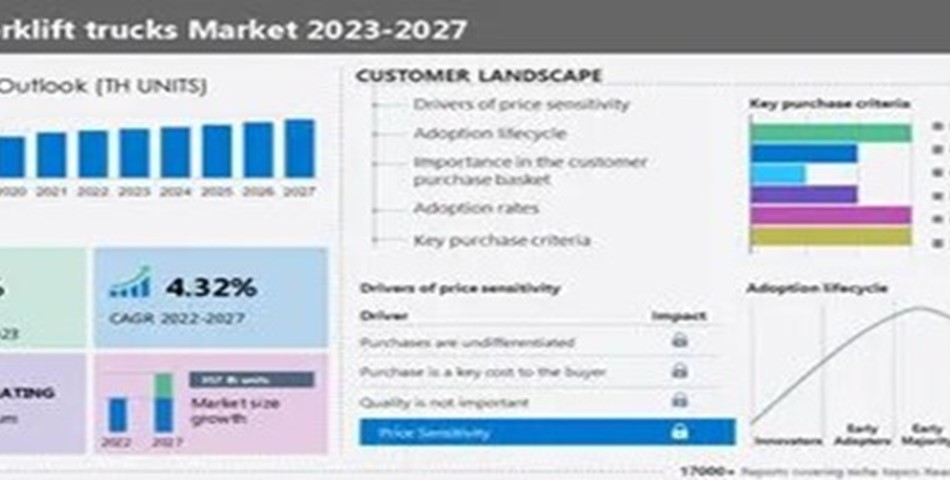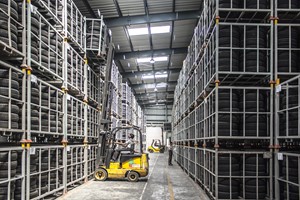The forklift trucks market size is estimated to grow by 357 thousand units from 2022 to 2027, according to Technavio. The market is estimated to grow at a CAGR of 4.32% during the forecast period. However, the growth momentum will progress. APAC held the largest share of the global market, and the market in the region is estimated to witness an incremental growth of 52% during the forecast period. For more insights on the historic data (2017 to 2021) and forecast market size (2023 to 2027)
Segment Overview
Technavio has segmented the market based on class type (class III, class V, class I, class II, and class IV), type (electric and internal combustion engine), and geography (APAC, Europe, North America, Middle East and Africa, and South America).
The market share growth in the class III segment will be significant during the forecast period. This segment of the global forklift trucks market contains electric hand rider trucks and pallet jacks. Moreover, this type of forklift truck is hand controlled through a steering tiller and is available as either counterbalanced or straddle-type walk-behind stackers. About 5 tons are the load capacity of these forklift trucks. Ideally suited for short distances and small warehouses, the class III forklift trucks may be powered by lithium-ion batteries, and these forklifts find advanced applications in warehouses and production plants that need intermediate logistics options between the unloading and storage operations. Their compatibility with other heavy material handling equipment makes them a viable choice for small-scale construction applications. As class III forklift trucks do not use non-renewable fuel sources, their adoption is anticipated to grow rapidly during the forecast period.
Geography Overview
By geography, the global forklift trucks market is segmented into APAC, Europe, North America, the Middle East and Africa, and South America. The report provides actionable insights and estimates the contribution of all regions to the growth of the global forklift trucks market.
APAC is projected to contribute 52% by 2027. Technavio's analysts have elaborately explained the regional trends and drivers that shape the market during the forecast period. The forklift trucks market in APAC is primarily driven by the rapid growth of key industries such as the construction and e-commerce industries in emerging economies. Japan has been a traditionally strong market for forklift trucks, and emerging markets such as India and China are witnessing steady growth in construction activity. Forklift trucks are finding increased application in the construction market.
Insights on the market contribution of various segments, including country and region wise, historic (2017 to 2021), and forecast market size (2023 to 2027)
Forklift Trucks Market – Market Dynamics
Key factor driving market growth.
The key factor driving the growth of the global forklift truck market is the rapid growth in the construction sector. Over the last few years, the growth in global construction activity has fostered the growth of the global forklift trucks market. Advanced economies such as the US and Western Europe witnessed fast growth in building construction and renovation in 2019. Due to the implementation of the Energy Efficiency Directive (EED) formulated by the EC in 2012, Western Europe experienced the renovation of public buildings, with the desire to achieve zero building emissions by 2020. However, government policies such as India's Make in India and China's BRI will continue to drive the growth of commercial construction and infrastructural development. Further, the flexibility and functional speed delivered by forklift trucks for applications in the construction sector, particularly for repeated material handling tasks, will boost growth in the adoption of forklifts in the construction sector, thereby fueling the growth of the global forklift trucks market during the forecast period.
Leading Trends Influencing the Market
The primary trend in the global forklift truck market is fuel-cell-powered forklift trucks. The introduction of forklifts powered by hydrogen fuel cells is an influential development in forklift truck technology. With manufacturers of forklift trucks increasingly emphasizing R&D. For instance, several vendors, such as Toyota Industries and KION GROUP, are coming up with fuel-cell-powered forklift truck models. Apart from significantly lowering the carbon footprint of forklift trucks, fuel cell-powered forklifts improve operational efficiency owing to the less downtime involved. Moreover, hydrogen fuel cells need to be replaced only once in ten years, as opposed to lead batteries that need replacement every 3-4 years. Furthermore, unlike battery-powered forklift trucks that experience a drop in their performance toward the end of the charge cycle, fuel cell-powered forklift trucks deliver constant performance throughout a charge cycle. Hydrogen is derived from natural gas that is priced much lower than crude oil, making hydrogen fuel less expensive than diesel and LPG. Therefore, due to factors such as improved performance, less need for maintenance, and environmental benefits, fuel cell-powered forklift trucks are expected to find increased demand during the forecast period.
Major Challenges Hindering the Market Growth
The shortage of skilled operators is a major challenge that may impede the global forklift truck market growth. Training of personnel with relevant expertise for the operation of a forklift truck is required due to the problems encountered when carrying out material and logistics operations in different end-user industries. In the US, OSHA issued a rule with effect from November 2017, making it compulsory for every forklift operator in a workplace to be trained and certified to operate forklift trucks. Moreover, workers are finding it increasingly challenging to find experienced operators to cater to the growing demand in end-user industries. The shortage of skilled and experienced operators is mainly due to the over-dependence on the existing certified forklift operators, leading to higher wages and overuse of these operators. Furthermore, such kinds of shortages contribute to the delay and loss in the profitability of projects. Therefore, the lack of skilled operators for forklift trucks will continue to pose a significant challenge to the growth of the global forklift trucks market during the forecast period.
|
Acknowledgement |
|
|
Entity Name |
Technavio |
|
URL |
|
|
Author |
Jesse Maida |













